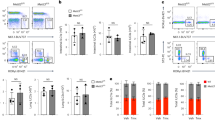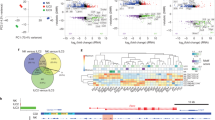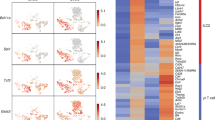Abstract
How T cells regulate interleukin 4 (IL-4) expression is not completely understood. We show here that single-positive thymocytes express IL-4, but attenuate GATA-3 expression, recruit DNA methyltransferases (Dnmts) to the Il4-Il13 locus and downregulate IL-4 expression as they mature into T cells. Type 2 polarization blocks Dnmt1 recruitment, enhances histone H3 Lys4 methylation (indicative of accessible chromatin) and initiates DNA demethylation of the locus. Dnmt1−/− CD4 and CD8 T cells derepress IL-4 expression considerably, demethylate DNA and increase H3 Lys4 methylation without affecting GATA-3 expression, demonstrating that Dnmt1 and DNA methylation are essential for proper Il4 regulation. These results indicate that Dnmts, DNA and histone methylation, and transcription factors 'collaborate' to determine appropriate Il4 expression patterns.
This is a preview of subscription content, access via your institution
Access options
Subscribe to this journal
Receive 12 print issues and online access
$209.00 per year
only $17.42 per issue
Buy this article
- Purchase on Springer Link
- Instant access to full article PDF
Prices may be subject to local taxes which are calculated during checkout






Similar content being viewed by others
References
Smale, S.T. & Fisher, A.G. Chromatin structure and gene regulation in the immune system. Annu. Rev. Immunol. 20, 427–462 (2002).
Murphy, K.M. & Reiner, S.L. The lineage decisions of helper T cells. Nat. Rev. Immunol. 2, 933–944 (2002).
Ho, I.C. & Glimcher, L.H. Transcription: tantalizing times for T cells. Cell 109, S109–120 (2002).
Ansel, K.M., Lee, D.U. & Rao, A. An epigenetic view of helper T cell differentiation. Nat. Immunol. 4, 616–623 (2003).
Asnagli, H. & Murphy, K.M. Stability and commitment in T helper cell development. Curr. Opin. Immunol. 13, 242–247 (2001).
Avni, O. et al. TH cell differentiation is accompanied by dynamic changes in histone acetylation of cytokine genes. Nat. Immunol. 3, 643–651 (2002).
Guo, L. et al. In TH2 cells the Il4 gene has a series of accessibility states associated with distinctive probabilities of IL-4 production. Proc. Natl. Acad. Sci. USA 99, 10623–10628 (2002).
Lee, D.U., Agarwal, S. & Rao, A. Th2 lineage commitment and efficient IL-4 production involves extended demethylation of the Il4 gene. Immunity 16, 649–660 (2002).
Santangelo, S., Cousins, D.J., Winkelmann, N.E. & Staynov, D.Z. DNA methylation changes at human Th2 cytokine genes coincide with DNase I hypersensitive site formation during CD4+ T cell differentiation. J. Immunol. 169, 1893–1903 (2002).
Fields, P.E., Kim, S.T. & Flavell, R.A. Cutting edge: changes in histone acetylation at the Il4 and Ifng loci accompany Th1/Th2 differentiation. J. Immunol. 169, 647–650 (2002).
Hutchins, A.S. et al. Gene silencing quantitatively controls the function of a developmental trans-activator. Mol. Cell 10, 81–91 (2002).
Bird, A. DNA methylation patterns and epigenetic memory. Genes Dev. 16, 6–21 (2002).
Bird, A.P. & Wolffe, A.P. Methylation-induced repression—belts, braces, and chromatin. Cell 99, 451–454 (1999).
Jones, P.A. & Takai, D. The role of DNA methylation in mammalian epigenetics. Science 293, 1068–1070 (2001).
Li, E. Chromatin modification and epigenetic reprogramming in mammalian development. Nat. Rev. Genet. 3, 662–673 (2002).
Meehan, R.R. DNA methylation in animal development. Semin. Cell Dev. Biol. 14, 53–65 (2003).
Lee, P.P. et al. A critical role for Dnmt1 and DNA methylation in T cell development, function, and survival. Immunity 15, 763–774 (2001).
Lee, H.J. et al. GATA-3 induces T helper cell type 2 (Th2) cytokine expression and chromatin remodeling in committed Th1 cells. J. Exp. Med. 192, 105–115 (2000).
Lee, G.R., Fields, P.E. & Flavell, R.A. Regulation of Il4 gene expression by distal regulatory elements and GATA-3 at the chromatin level. Immunity 14, 447–459 (2001).
Ranganath, S. et al. GATA-3-dependent enhancer activity in Il4 gene regulation. J. Immunol. 161, 3822–3826 (1998).
Murphy, K.M. et al. Signaling and transcription in T helper development. Annu. Rev. Immunol. 18, 451–494 (2000).
Avni, O. & Rao, A. T cell differentiation: a mechanistic view. Curr. Opin. Immunol. 12, 654–659 (2000).
Takemoto, N. et al. Th2-specific DNase I-hypersensitive sites in the murine Il13 and Il4 intergenic region. Int. Immunol. 10, 1981–1985 (1998).
Richards, E.J. & Elgin, S.C. Epigenetic codes for heterochromatin formation and silencing: rounding up the usual suspects. Cell 108, 489–500 (2002).
Jenuwein, T. & Allis, C.D. Translating the histone code. Science 293, 1074–1080 (2001).
Kouzarides, T. Histone methylation in transcriptional control. Curr. Opin. Genet. Dev. 12, 198–209 (2002).
Zegerman, P., Canas, B., Pappin, D. & Kouzarides, T. Histone H3 lysine 4 methylation disrupts binding of nucleosome remodeling and deacetylase (NuRD) repressor complex. J. Biol. Chem. 277, 11621–11624 (2002).
Lachner, M., O'Sullivan, R.J. & Jenuwein, T. An epigenetic road map for histone lysine methylation. J. Cell Sci. 116, 2117–2124 (2003).
Kim, G.D., Ni, J., Kelesoglu, N., Roberts, R.J. & Pradhan, S. Co-operation and communication between the human maintenance and de novo DNA (cytosine-5) methyltransferases. EMBO J. 21, 4183–4195 (2002).
Leonhardt, H., Page, A.W., Weier, H.U. & Bestor, T.H. A targeting sequence directs DNA methyltransferase to sites of DNA replication in mammalian nuclei. Cell 71, 865–873 (1992).
Bachman, K.E., Rountree, M.R. & Baylin, S.B. Dnmt3a and Dnmt3b are transcriptional repressors that exhibit unique localization properties to heterochromatin. J. Biol. Chem. 276, 32282–32287 (2001).
Agarwal, S. & Rao, A. Modulation of chromatin structure regulates cytokine gene expression during T cell differentiation. Immunity 9, 765–775 (1998).
Glimcher, L.H. & Murphy, K.M. Lineage commitment in the immune system: the T helper lymphocyte grows up. Genes Dev. 14, 1693–1711 (2000).
Szabo, S.J. et al. A novel transcription factor, T-bet, directs Th1 lineage commitment. Cell 100, 655–669 (2000).
Ouyang, W. et al. Inhibition of Th1 development mediated by GATA-3 through an Il4-independent mechanism. Immunity 9, 745–755 (1998).
Ho, I.C., Hodge, M.R., Rooney, J.W. & Glimcher, L.H. The proto-oncogene c-maf is responsible for tissue-specific expression of interleukin-4. Cell 85, 973–983 (1996).
Reiner, S.L. Helper T cell differentiation, inside and out. Curr Opin Immunol 13, 351–355 (2001).
Lyko, F. et al. Mammalian (cytosine-5) methyltransferases cause genomic DNA methylation and lethality in Drosophila. Nat. Genet. 23, 363–366 (1999).
Rhee, I. et al. DNMT1 and DNMT3b cooperate to silence genes in human cancer cells. Nature 416, 552–556 (2002).
Bruniquel, D. & Schwartz, R.H. Selective, stable demethylation of the interleukin-2 gene enhances transcription by an active process. Nat. Immunol. 4, 235–240 (2003).
Fuks, F. et al. The methyl-CpG-binding protein MeCP2 links DNA methylation to histone methylation. J. Biol. Chem. 278, 4035–4040 (2003).
Fuks, F., Burgers, W.A., Brehm, A., Hughes-Davies, L. & Kouzarides, T. DNA methyltransferase Dnmt1 associates with histone deacetylase activity. Nat. Genet. 24, 88–91 (2000).
Robertson, K.D. et al. DNMT1 forms a complex with Rb, E2F1 and HDAC1 and represses transcription from E2F-responsive promoters. Nat. Genet. 25, 338–342 (2000).
Rountree, M.R., Bachman, K.E. & Baylin, S.B. DNMT1 binds HDAC2 and a new co-repressor, DMAP1, to form a complex at replication foci. Nat. Genet. 25, 269–277 (2000).
Fuks, F., Hurd, P.J., Deplus, R. & Kouzarides, T. The DNA methyltransferases associate with HP1 and the SUV39H1 histone methyltransferase. Nucleic Acids Res. 31, 2305–2312 (2003).
Goll, M.G. & Bestor, T.H. Histone modification and replacement in chromatin activation. Genes Dev. 16, 1739–1742 (2002).
Ayyanathan, K. et al. Regulated recruitment of HP1 to a euchromatic gene induces mitotically heritable, epigenetic gene silencing: a mammalian cell culture model of gene variegation. Genes Dev. 17, 1855–1869 (2003).
Grogan, J.L. et al. Early transcription and silencing of cytokine genes underlie polarization of T helper cell subsets. Immunity 14, 205–215 (2001).
Hashimshony, T., Zhang, J., Keshet, I., Bustin, M. & Cedar, H. The role of DNA methylation in setting up chromatin structure during development. Nat. Genet. 34, 187–192 (2003).
Fitzpatrick, D.R. et al. Distinct methylation of the interferon γ (IFN-γ) and interleukin 3 (IL-3) genes in newly activated primary CD8+ T lymphocytes: regional IFN-γ promoter demethylation and mRNA expression are heritable in CD44highCD8+ T cells. J. Exp. Med. 188, 103–117 (1998).
Saccani, S., Pantano, S. & Natoli, G. Two waves of nuclear factor κB recruitment to target promoters. J. Exp. Med. 193, 1351–1359 (2001).
Acknowledgements
We thank A. Kelso, H. Harowicz, B. Fallen, K. Allen and F. Lewis for their support and technical assistance, and all members of the Wilson laboratory for discussions. This work was supported by awards from the National Institutes of Health (GM20865, HD18184 and HD39454) and the March of Dimes.
Author information
Authors and Affiliations
Corresponding author
Ethics declarations
Competing interests
The authors declare no competing financial interests.
Supplementary information
Supplementary Figure 1.
DNA methylation of individual CpG sites within the Il4/Il13 locus of resting SP thymocytes, resting naïve T cells and fully polarized TH1 and TH2 cell lines. DNA methylation analysis is shown for individual CpGs within the CNS-1, Il4 promoter and intronic enhancer of resting (t0) or activated (d3) SP CD4 or SP CD8 thymocytes, naïve CD4 or CD8 T cells, and naïve CD8 T cells activated under type 2 polarized conditions for three days. Included for comparison is DNA methylation analysis of the long-term TH1 cell line, AE7, and TH2 cell line, D10.G4.1; AE7 shows overall DNA methylation content similar to resting naïve CD4 and CD8 T cells, whereas D10.G4.1 demonstrates the loss of DNA methylation in the Il4/Il13 locus of fully polarized TH2 cells. Results are the percent of methylated cytosines and represent the average of 17-55 sequenced alleles from 2-5 independent experiments for each primary cell type and >20 alleles for cell lines AE7 and D10.G4.1. (PDF 76 kb)
Supplementary Figure 2.
Representative raw data from Dnmt1 ChIP experiments. (a) NIH3T3 cell extracts (lane 1) or extracts immunoprecipitated with an (NH4)2SO4 concentrated (lane 2) or an affinity purified (lanes 3 and 4) preparation of the polyclonal anti-murine Dnmt1 antibody generated in this study were separated by SDS-PAGE and then analyzed by western blot. A different antibody to murine Dnmt1 kindly provided by R. Jaenisch (HM334, Tucker, K.L. et al., PNAS USA 93:12920-12925 (1996)) was used to detect Dnmt1 in combination with HRP-conjugated goat anti-rabbit IgG and the ECL detection system (Amersham). The upper band noted by the arrow is murine Dnmt1and the dark lower band in lanes 2-4 is due to the presence of rabbit Ig in the immunoprecipitated samples. (b) Real-time PCR raw data are shown to demonstrate the specificity and level of detection of the Dnmt1 ChIP assay. The top panel represents a positive sample and shows the amplification plot (PCR cycle number versus fluorescence signal) for chromatin immunoprecipitated with Dnmt1 antisera or pre-immune sera. The Ct value (the PCR cycle at which fluorescence rises above a minimal threshold) for each sample is given. A lower Ct value indicates a larger amount of starting material, and the difference in Ct between pre-immune and immune sera reflects specific ChIP. PCR products were a single band of the appropriate size as shown in the inset photograph of an agarose gel, and were confirmed by melt curve analysis (data not shown). The second panel shows the amplification plot and Ct values for a negative sample from the same experiment. The third panel shows the amplification plot for duplicate cDNA standards spanning four logs in concentration. The bottom graph is log [DNA] versus Ct value from the standard curve. The line equation generated by the standards is used to calculate the concentration of DNA in each ChIP sample. The specific IP DNA values reported in the manuscript are calculated by the following equation: ([DNA]specific IP – [DNA] non-specific IP) / [DNA]input. The [DNA]input is an aliquot of pre-IP sample of sheared chromatin and is used to normalize a sample to the amount of chromatin added to each ChIP. Analysis was performed by real-time PCR using a DNA Engine Opticon (MJ Research). (c) Real-time PCR data from Dnmt1 ChIP of activated wildtype (WT) and Dnmt1-/- cells. The amplification plots, Ct values and standard curve are shown. The Ct value for Dnmt1-/- cells is comparable with the non-specific (pre-immune) IP from WT cells. (PDF 78 kb)
Supplementary Figure 3.
Representative raw data from Dnmt3b ChIP experiments. (a) Real-time PCR raw data are shown as in Supplementary Figure 2b to demonstrate the specificity and level of detection of the Dnmt3b ChIP assay. The top panel represents a positive sample chromatin immunoprecipitated with anti-Dnmt3b or mouse IgG (mIgG). The second panel shows a negative sample from the same experiment. The third panel and bottom graph show duplicate cDNA standards spanning three logs in concentration, indicating that Ct values above 33 are not accurately quantitative. For control samples with Ct values below the range of the standard curve (such as in the top panel), the value of the lowest point on the standard curve is used to determine the specific IP DNA. (b) Real-time PCR raw data from one sample analyzed at two different regions, showing a positive Dnmt3b ChIP at the CNS-1 region, and a negative Dnmt3b ChIP at the Il4 promoter. The bottom panels show the standard curves for each PCR reaction. (PDF 43 kb)
Rights and permissions
About this article
Cite this article
Makar, K., Pérez-Melgosa, M., Shnyreva, M. et al. Active recruitment of DNA methyltransferases regulates interleukin 4 in thymocytes and T cells. Nat Immunol 4, 1183–1190 (2003). https://doi.org/10.1038/ni1004
Received:
Accepted:
Published:
Issue Date:
DOI: https://doi.org/10.1038/ni1004
This article is cited by
-
Whole-genome profiling of DNA methylation and hydroxymethylation identifies distinct regulatory programs among innate lymphocytes
Nature Immunology (2022)
-
DNA demethylation of the TIM-3 promoter is critical for its stable expression on T cells
Genes & Immunity (2016)
-
DNA methylation: roles in mammalian development
Nature Reviews Genetics (2013)
-
Ethnic Differences in DNA Methyltransferases Expression in Patients with Systemic Lupus Erythematosus
Journal of Clinical Immunology (2013)
-
Plasticity of DNA methylation in mouse T cell activation and differentiation
BMC Molecular Biology (2012)



